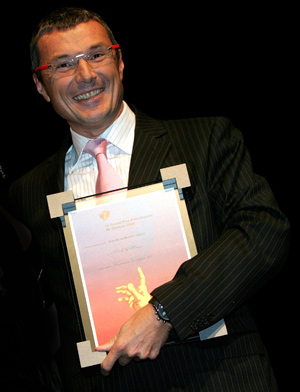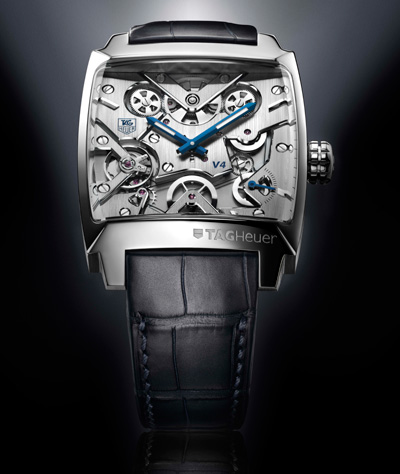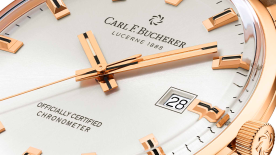Press release

What is the role of the Monaco V4 in the TAG Heuer universe, what were the sources of its inspiration, and where does the name V4 come from?
We have enjoyed a privileged position in the avant-garde sports watches and chronographs market since 1860, mainly because we innovate more than any other watch brand. We are the only brand that can offer electronic and mechanical chronograph accuracy to 1/10th, 1/100th and 1/1,000th of a second. Technology, design and innovation are the three major components of our brand's DNA, and it is through these that we push Swiss watchmaking traditions ever forward.
The inspiration for the Monaco V4 is the high-end super sports car — a territory that TAG Heuer has historically occupied since 1911, when it created the "Time of Trip," the world's first dashboard chronograph, followed by the "Autavia" dashboard stopwatch in 1933, and carrying on right through to today, with our official partnership with Mercedes-Benz in GT with the SLR and with McLaren in Formula 1. With its century and a half history at the avant-garde of Swiss watch design and engineering, the brand TAG Heuer is also in itself a source of inspiration.
The name V4 is derived from the four spring barrels of the movement, which are mounted on a V-shaped platinum main plate angled at +/-13 degrees, like the cylinders of a high-performance racing engine. The principle of a 5 notched micro-belt transmission has its roots in automotive design, where for example, in the combustion cycle, the distributor belt synchronizes the movement of the engine's valves and pistons
Why did you choose the Monaco series for the V4? Does it fit?
It seemed quite logical to follow the Monaco's resolutely innovative heritage, which exemplifies TAG Heuer's desire to always push beyond the limits of traditional watchmaking. The original Monaco of 1969 had a unique shape that completely broke with conventional watchmaking aesthetics. Equipped with the Chronomatic Caliber 11, the first automatic chronograph movement with micro-rotor, the Monaco embodied our motto: "TAG Heuer Swiss Avant-Garde Since 1860".
I love the Monaco! It is mythical, a true icon, and that is why we have not dared to touch it for years. It reflects the aesthetic and pioneering instincts of our brand, which continues to generate revolutionary ideas and then transform them into products. With the Monaco V4, TAG Heuer seeks to rethink, redesign and reinvent the mechanical movement. It is a perfect example of our commitment to innovation. As for the future of the brand, my motto is: take the best of the past, add to it the best of today, and see where it leads!
You presented the Monaco V4 at BaselWorld 2004, and you're only now launching it, 5 years later, in 2009. Why did it take so long?
The Monaco V4 in 2004 was presented as a Concept Watch, which means that, as in the automotive industry, it was designed to outline the future development of TAG Heuer. In the world of watchmaking, the average time needed to develop a new movement from first draft to final product is 3 to 5 years, so with the V4 – which represents a genuine revolution in terms of mechanical watch movement — we are in the same timeframe. We did not want to compromise the quality and reliability of the product by bringing it into the market too quickly. The future customers of the Monaco V4 demands the best, and we must always go beyond their expectations.
At a time when all other companies are investing in the mass production of their own movements, why adopt a different strategy by launching a movement such as V4, which will only be produced at low volumes? Will you use this new movement in other watches in the future?
We never intended to make a mass-produced movement. This is a very complicated watch — an innovative and prestigious movement that showcases our expertise in high-end watchmaking and engineering. The V4 movement is not intended to replace other movements we use in "commercial" watches. Our single driving goal has been to manufacture this unique series of 150 luxury pieces.
Where are the components manufactured? The V4 belts, for example?
In addition to our new manufacturing unit in Cornol, which is dedicated to our new Calibre 1887 movement, TAG Heuer has a manufacturing and assembly facility there for its major complications, and for the manufacture of many V4 components. However, the workshop does not have the machinery and processes needed to manufacture belts or ball bearings. The belts are manufactured externally, as are other Calibre V4 components. The names and location of our sub-contractors are confidential, but what I will tell you is that the belts are not made by anyone in the watch industry!
Is the movement assembled in your facilities?
Yes, the entire Calibre V4 is assembled and tested by us, i.e., T1 and T2. Our master watchmaker was awarded the prestigious title of Meilleur Ouvrier de France in 2004. The platinum cases are manufactured in our Cornol facility.
Who will buy the Monaco V4?
The Monaco V4 will be produced in platinum in a limited edition of 150 pieces. It's more a collector's piece that a watch for keeping time — in fact, when you look at it, you sometimes even forget to pay attention to what the time is!
This world premiere will draw collectors and watch enthusiasts who enjoy strong and innovative designs as well as watches with major complications. TAG Heuer is turning towards more demanding customers, those accustomed to the quality of finish only found at the most prestigious levels of Swiss watchmaking. These customers are primarily attracted to TAG Heuer because of its breakthrough innovations in mechanical movement design and engineering. TAG Heuer already has many followers, as evidenced by the brand's fan blogs and Facebook friends.
Which distribution policy do you envisage for this limited series?
These 150 luxury platinum models are truly exceptional. Given the limited quantity, the Monaco V4 will only be made available at select points of sale in our global sales network.

READ: Monaco V4, As a Concept Watch...
Questions & responses of Guy Semon, TAG Heuer V.P. Sciences & Engineering
What makes the Monaco V4 so unique? What are its features? What makes this watch different from other complication watches?
Like a car engine, the fundamental mechanical factors in a watch are: transmission, friction and power. It is from this premise that the team of engineers and watchmakers at TAG Heuer created new principles that genuinely break with conventional watchmaking. In the Calibre V4 movement, the gear and pinion part of a traditional mechanical movement's transmission is replaced by three belts. In addition, two fitted belts carry out the barrel coupling, on a 13° incline. And finally, the spring barrels have a linear tungsten mass that oscillates on a plane between the two pairs of cylinders.
The Monaco V4 involved a great effort in terms of research and development and has revolutionized the watchmaking industry. What are the impacts for TAG Heuer?
To create a movement like the Monaco V4, you have to entirely rethink mechanical watch architecture — above and beyond the technical process required to manufacture a very high complication that will meet TAG Heuer's very stringent quality criteria. This process has helped make the Monaco V4 the first watch with major complications that can be worn in all sports, including extreme sports. The entire study, from prototype to experimentation, was performed by an R&D team dedicated to the project. This team is now the Movement Research department, and is already working on revolutionary new developments and innovations. TAG Heuer is currently the only manufacturer capable, at very short notice, of developing any complication and innovative architecture it wishes. To achieve this, TAG Heuer has developed its own calculation, modeling and simulation tools.
You took charge of R&D at TAG Heuer in 2004. The development of the V4 was a real technical challenge, but what about the human challenge?
The design of the V4 has nothing to do with existing principles of watchmaking. We started with a blank slate and had to invent a completely new architecture, overcome the problem of 13° angles, discover a way of winding 4 barrels with a linear mass... We also had to develop manufacturing processes for belts, some with metal strands. Making a V4 required conceptual data models based on complex physics and mathematical models. The design and implementation of the V4 involved a variety of fields related to engineering and metallurgy in particular, as well as mechanics, digital and formal programming constraints...
Are there significant differences between the Concept Watch and this year's series launch?
There is a huge difference between the prototype and the commercial version, particularly in terms of the reliability and quality control standards required by TAG Heuer. How the Monaco V4 was designed in 2004 was not compatible with large-scale production. We had to rethink it entirely, and completely rebuild it. In a little over 2 years, the construction of the new V4 movement was finalized. We also presented several operating prototypes at Baselworld 2007.
Fundamentally, the construction of the new movement is different from the Concept Watch in that the wheels have been replaced by belts, and the energy produced by the linear oscillating mass is stored in 4 barrels in 2 by 2 series. However, the aesthetics is totally faithful to the Concept Watch.




